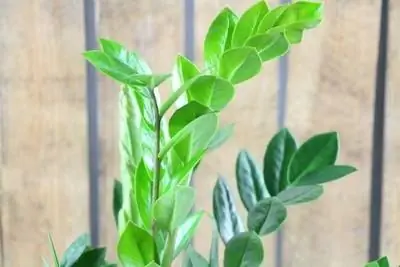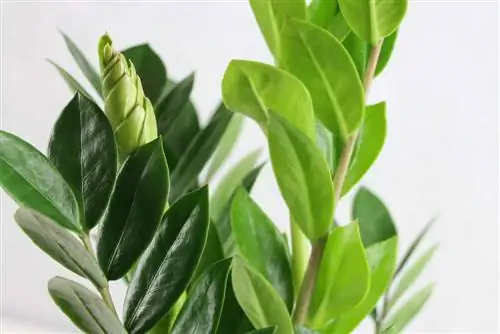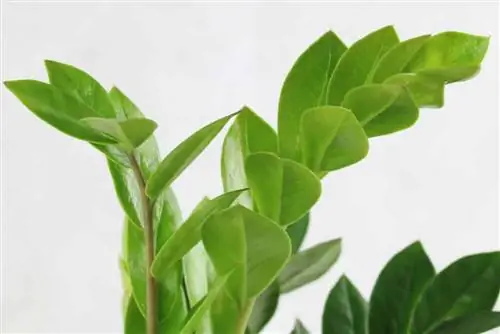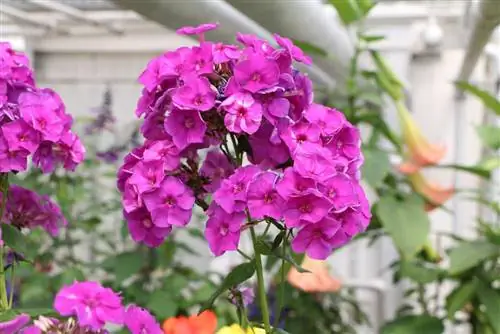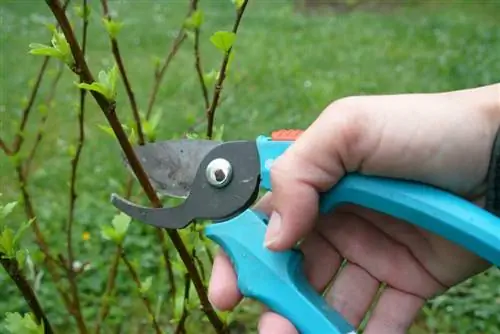- Author admin [email protected].
- Public 2024-01-31 11:14.
- Last modified 2025-06-01 06:48.
For some time now, an easy-care arum plant has been available in Germany that makes even plant lovers without a green thumb happy: Zamioculcas zamiifolia, perhaps that is why it is given the German name Glücksfeder. Below you will find an overview of the care, propagation and cutting of the beautiful succulents:
Profile
- Family: Araceae
- Genus: Zamioculcas
- Botanical name: Zamioculcas zamiifolia
- German name: Lucky Feather, Zamie
- Growth height: 45 to 90 cm
- Effort: Easy-care beginner plant
- Cultivation as: houseplant
- Decorative value: ornamental leaf plant
- Setting up options: Grows everywhere, faster in bright locations
Growth habit and location
The Zamioculcas zamiifolia is a perennial tropical plant from Africa that behaves as if it had been “invented” as a houseplant for temperate latitudes: It develops many shoots next to each other, with strong, shiny leaves up to the size of your hand Height suitable for living rooms around 50 - 90 cm.
The lucky feather grows in its homeland on mountainous, alternately exposed forest and bush areas and is happy with almost any location here. The optimal growth temperature is between 18 and a good 26 °C (65° to 80 °F), so in German households the Zamie grows at optimal temperatures throughout.
Bright, indirect light is what the lucky feather prefers; Experiments have been carried out with regard to the darkness it can withstand: the Zamie also grows at a meager 270 lux, which corresponds to a location 70 cm away from a 100 W light bulb. The Zamie grows faster with a lot of light, slower in darker locations and with darker leaves.
The ambient temperature also influences the speed of growth; in warm temperatures, Zamioculcas zamiifolia produces more leaves. A summer location outdoors is fine, you just can't expect the Zamie to have temperatures below 15 °C, it doesn't know it and doesn't like it. The blazing midday sun doesn't cause sunburn on the leaves until you get used to it, but it prefers gentle morning and evening sun.
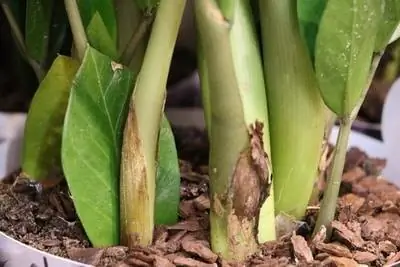
The shiny leaves of the lucky feather shine because they are covered with a natural protective layer. This natural protective layer occasionally needs a little care, otherwise dust will settle and the shine will be lost. You can easily wipe the leaves with a damp sponge or cloth. The use of shine spray is not recommended due to the high water content of the Zamioculcas leaves; the ingredients probably disrupt the plant metabolism. The best care for the natural seal is said to be rubbing with the inside of a banana peel.
Not a poisonous plant, but a poison remover
The Zamie is usually described as poisonous in all parts of the plant. Even small amounts of plant material can trigger symptoms such as unpleasant mucous membrane irritation. It is said to be only slightly poisonous, but if the symptoms are more severe, medical treatment is advisable - normally concerned parents will probably leave the lucky feather in the store after reading lines like this.
Therefore, a more precise classification follows, which can give the lucky feather access to households with children (but may protect adults with sensitive skin from unpleasant surprises):
Zamioculcas zamiifolia contains oxalic acid as crystalline calcium oxalate, neither of which are substances that should be consumed in large quantities or brought into contact with sensitive skin. But also no poisons that make us drop dead: calcium oxalate in crystal form can only irritate the skin because it is not absorbed; Oxalic acid could be dangerous if you consume around 5 kg of Zamioculas leaves - consuming 5 kg of rhubarb, carambola, chard, spinach with an equally critical oxalic acid content is certainly closer.
Oxalate needles on the skin are annoying, but not poisoning, which is why the lucky feather does not appear in the official list of federal poisonous plants (more information about them: www.bfr.bund.de/cm/343/vergiftungen -with-plants.pdf).
So skin contact remains. Yes, you should not put plant juice containing calcium oxalate crystals in your eyes, mouth or other mucous membranes; yes, people with sensitive skin should wear gloves when handling the plant, children should keep their distance.
But you can do something about the pricking: The tiny crystal needles are bright, hexagonal and work under polarized light (e.g. B. LCD monitor) can be clearly seen, they can be removed with patience, a magnifying glass and tweezers. Or you can dip your hands in a warm solution of 2/3 lemon juice and 1/3 water for 40 minutes (warm up in between). Calcium oxalate dissolves in acid and can be rinsed off. Pat dry and do not rub, repeat the procedure if necessary.
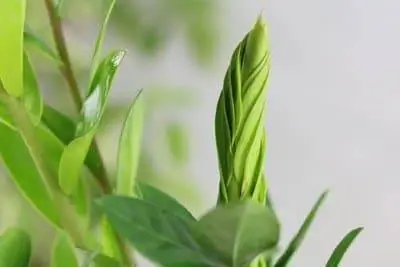
Instead of secreting poison, the zamie extracts toxins from the air: in 2014, researchers at the University of Copenhagen showed that lucky feathers filter potentially dangerous VOCs (volatile organic compounds) from the air, benzene, toluene, ethylbenzene and xylene in decreasing order of effectiveness.
Soil, substrate, repotting
Undemanding is undemanding, also when it comes to potting soil:
- Ready-made palm soil is recommended
- Consists of potting soil, clay, humus, lava stones, carbonated lime, slow-release fertilizer
- Ready potting soil and simple garden soil can also be enriched with these ingredients
- If you can't find it in the garden, you can find it in the hardware store or garden center.
- Carbonate lime surrounds the breakfast egg
The lucky feather develops a root system with a thick water storage tuber and rhizomes extending from it, which can be clearly seen in these pictures of offspring: indoor-plants.net/wp-content/uploads/2013/08/Zamioculcas-Cuttings. jpg.
The pot must be large enough for rhizomes to spread. But not too big: If the first root runners do not feel any limitation, more rhizomes than plants will grow in the upper area for quite a long time - until a well-established Zamioculcas zamiifolia sets about cracking the maximum height of around 2 meters described in our latitudes.
In natural locations, the rhizomes often grow horizontally through the earth because the rocky ground leaves them no other choice. You can therefore place the plant in a shallower pot; However, the tuber and rhizome also like to adapt to the depth of the pot: indoor-plants.net/wp-content/uploads/2013/08/Zamioculcas-Rhizome.jpg.
Depending on the location, the Zamioculcas zamiifolia grows quickly. At the latest when the roots look like the last picture, the plant needs to be repotted (initially usually annually, later every two to three years). This is best done at the beginning of the growth phase in March or April, you proceed as usual:
- Unpot Zamie, shake off old soil
- Quickly make sure that there are no pest eggs in the soil (rare for zamias)
- If in doubt, wash off the old soil completely and replace it
- Look at the roots and cut away damaged rhizomes
- If applicable. also separate rhizomes for propagation
- Place the plant with new soil in the next larger pot
Watering and fertilizing
The Zamie uses the lowest petiole of the pinnate leaves and the rhizome to store water for bad times. When it is “well-filled”, the Zamie needs little water in relation to the number of leaves it has. It is watered regularly whenever the surface of the potting soil has just dried out.
When it is well filled
You should check quickly after purchase whether this is the case: push the shoot, you will notice by the springs whether the shoot is bulging or reacts softly and hesitantly. Lucky feathers with rather soft shoots/leaves are given more water for a while until they stand really tight and upright (can take a while with dried out plants, zamias contain 91% water in the leaves and 95% water in the petioles/shoot bases, that is unusually much).

Plants with full water reservoirs should thrive best if they are kept a little too dry rather than too moist. If you forget to water, hardly anything will happen for a long time, while waterlogging can quickly lead to root rot.
The lucky feather needs nutrients as soon as it starts sprouting in spring, but also in rather moderate quantities: once a month, liquid fertilizer in normal concentration should usually be enough.
Hydroponic husbandry
With its rhizomes, the lucky feather develops a stable foundation that enables it to be kept in hydroponics. However, this maintenance in water, a little stabilizing inorganic material and nutrient solution is quite a change for the plant. Which only young plants survive and which requires some preparation:
- Take the lucky feather out of the pot
- Carefully remove all soil from roots
- Shower roots
- Prepare the hydro pot with very coarse expanded clay
- Put “Naked” Zamie in the Hydro Pot
- Install water level indicator
- Place the pot in the waterproof planter
- Filling nutrient solution for hydroponics
- Refill water after water level indicator displays
- Nutrient solution must be added approximately every quarter
- Watch out for mold, replace expanded clay immediately if necessary
- Wash roots before repotting
- If mold infestation appeared quickly, add herbal fungicide to the nutrient solution
Bloom
The flower of the lucky feather is often described as inconspicuous. However, the Zamie develops the typical flask-like inflorescence of an arum plant, for which inconspicuous is actually not the right word.
Pictures of the flowers suggest other names, you can choose between the stinking finger: media.tumblr.com/tumblr_lhy4timxC01qdio77.jpg, puffed rice on the style: 666kb.com/i/c3r76arlfqh7apgdl.jpg" />
Winter rest at cooler temperatures is said to promote flower induction, as is very regular water supply (as is provided “automatically” in hydroponics); the flowers appear between mid-summer and early autumn.
Tip:
Articles about plants often talk about pruning plants, e.g. B. can be of crucial importance for fruit trees, hedges and bushes that grow densely inside; for the harvest, the development of the plants, the prevention of fungal attack. All garden plants and no houseplants. When it comes to houseplants, instructions for cutting are actually absurd, as the existing leaves and shoots were bought as room decorations. It is the same with the Zamioculcas zamiifolia, it is not pruned. Even dead leaves should be pulled off by hand; the stem stump under the “breaking point” can store water for several years.
Wintering
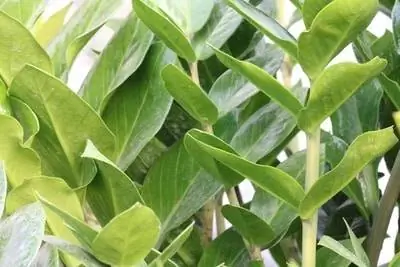
If possible, you should give the Zamie a winter rest period in a cool room (with temperatures between 16 and 18 °C). She then receives less water and no fertilizer. This is how you slow down the plant's metabolism in a way that saves energy, without slowing it down to the point where it becomes a deciduous plant that has to sprout all over again in the spring:
- Keep the Glücksfeder cooler, but not in temperatures below 16°C
- Water normally until mid-October or fill the hydraulic accumulator for the last time
- Watere more sparingly from late autumn to spring
- Before the next watering, the entire top third of the soil can now dry out
- So the Zamie gets through the winter without much growth, but in full green.
- Towards the end of February, watering is slowly increased
- Until the first fertilizer is available again at the start of budding
The lucky feather can also be cultivated in a warm room in a place that is as bright as possible. Compared to an outdoor summer parking space, the water requirement is also reduced here because it gets much less light than outside. For “that little bit of growth” over the winter, it needs little or no fertilizer (that’s up to you to decide - does it hardly grow at all or does it still grow with a little momentum?). If the pitch is in a very dry environment, the lucky feather will be happy about occasional mist of water from the spray can.
Propagate
In England, where plant culture is traditionally very important, the Zamioculcas zamiifolia (known as the “Zanzibar Gem”) has long been a well-known “house plant” that is usually propagated from leaf cuttings. It works like this:
- Every single shoot of the Zamie is a single “feather leaf”
- This imparipinnate leaf forms five to eight “pairs of feathers”
- A partner of such a pair of feathers is what we see as a leaf
- For propagation you don't need the whole leaf (the whole shoot), but just such an individual particle
- Place the lower end about 1/3 of the way into moist potting soil, cover the container
- Then you can forget about the whole thing for about a year
- The section of the leaf fragment visible above may be more or less weathered
- A small succulent water storage tuber develops underground
- Small, but still a tuber, it needs at least a year
- Now the offspring can be potted and cared for like a big zamie
- Exposing the tuber should accelerate shoot growth
You can continue to divide rhizomes (when repotting) or remove side shoots from them, but it doesn't work much faster; Actually, you are always well advised to believe English gardening traditions. The propagation is described in this (English-language) video: www.youtube.com/watch?v=rLz0NXj9S4g.

